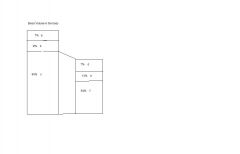![]()
![]()
![]()
Use LEFT and RIGHT arrow keys to navigate between flashcards;
Use UP and DOWN arrow keys to flip the card;
H to show hint;
A reads text to speech;
47 Cards in this Set
- Front
- Back
|
Nervous System that refers to brain & spinal cord.
|
CNS
|
|
|
any neural structure outside CNS is referred to as...
|
PNS
|
|
|
afferent fibers send info
|
towards CNS
|
|
|
efferent fibers send info
|
away from CNS (motor)
|
|
|
Name of fibers connecting/innervating skeletal muscle
|
Somatic motor fibers (mostly under voluntary control
|
|
|
These organs are under involuntary control, and are in the _______ nervous system
|
Visceral organs, Autonomic
|
|
|
In this division of the ANS, postganglionic neurons are typically within or near organ
|
Parasympathetic division
|
|
|
Thoraco-Lumbar is which division of ANS?
|
Sympathetic
|
|
|
Cranial Sacral is which division of ANS?
|
Parasympathetic
|
|
|
This part of the brain has significant influence on autonomic nerves. (influences preganglionic)
|
Hypothalamus
|
|
|
Cholinergic receptors are those that bind ____.(naturally occuring).
|
Acetylcholine
|
|
|
Adrenergic receptors are those that bind ______.(naturally occuring)
|
norepinephrine and epinephrine.
|
|
|
In parasympathetic nerves, preganglionic receptors are _____-_____(1) receptors, and postganglionic receptors are _____-_____(2) receptors.
|
(1)nicotinic-cholinergic
(2) muscarinic-cholinergic |
|
|
In sympathetic nerves, preganglionic receptors are _____-_____(1) receptors, while postganglionic receptors are _____-_____(2).
|
(1)nicotinic-cholinergic
(2)Beta/Alpha-Adrenergic |
|
|
Stimulation of beta-adrenergic receptors on the heart (increases/decreases) heart rate and force of contraction.
|
Increases
|
|
|
Stimulation of beta-adrenergic receptors on intestinal smooth muscle(increases/decreases) the number and force of contractions.
|
Decreases
|
|
|
Receptors for which the order of agonist potency is epinephrine> norepinephrine>>isoproterenol are known as _____.
|
alpha-adrenergic receptors
|
|
|
Receptors for which the order of agonist potency is isoproterenol >epineprine>>norepinephrine are known as____.
|
beta-adrenergic receptors
|
|
|
Agonists and antagonists of Alpha-adrenergic(most potent first)
|
Agonists: Epinephrine, norepinephrine, isoproterenol, and phenylephrine.
Antagonists: Phentolamine(mentioned in class), and phenoxybenzamine |
|
|
Agonists and antagonists of beta-adrenergic(most potent first)
|
Agonist: Isoproterenol, epinephrine, and norepinephrine.
Antagonist: Propanolol |
|
|
Agonist and antagonist for nicotinic-cholinergic
|
agonist: ACh, nicotine
Antagonist: curare(skeletal) |
|
|
Agonist and antagonist for muscarinic-cholinergic.
|
agonist: ACh, muscarine
Antagonist: Atropine |
|
|
What is ischemia?
|
Reduction in blood flow. Restriction in blood supply.
|
|
|
What is hypoxia?
|
Reduction in Oxygen.
|
|
|
What is hypercapnia?
|
Increased CO2, too much carbon dioxide in the blood.
|
|
|
a-heart
b-pulmonary c-systemic d-capillaries e-arteries f-veins |

label these percentages of blood volume to correspondings sections of circulatory system. (graph from class)
|
|
|
Anaerobic respiration creates lactic acid, increasing proton concentration in muscles, a condition known as....
|
Acidosis
|
|
|
Give cycle of blood flow through systemic and pulmonary. include oxygen and Carbon dioxide Xfer and relative concentration
|
Pulmonary: RA>RV>PA>pulmonary cap. (increase O2)>PV>>>>>>
Systemic: LA>LV>Aorta>Systemic cap.(decrease O2, Increase CO2)>Vena Cava(deoxygenated)>RA |
|
|
Function of valves
|
Prevent backflow of blood
|
|
|
How thick are capillaries
|
one cell thick
|
|
|
In which blood flow system is velocity lowest but has the greatest surface area?
|
Capillaries
|
|
|
What is a hemorrhage?
|
Loss of blood volume
|
|
|
List components of blood plasma(12 mentioned in class), and major component.
|
Major component is H2O. Amino acids, glucose and carbs, lipids, O2, CO2, N2,Plasma Proteins(globulins, albumin, and fibrinogen.
|
|
|
What % of blood volume is plasma?
|
55%
|
|
|
How viscous is plasma relative to water?
|
More viscous (roughly 1.8 times greater).
|
|
|
What is the osmolarity of Blood plasma?
|
200-300 Osmols/L.
|
|
|
What is the major formed element in blood
|
RBCs
|
|
|
What is the size of a RBC, what does it contain that binds to O2, and how long does a RBC live?
|
7-8 micrometers, hemoglobin, and they live about 120 days.
|
|
|
The proportion of blood volume that is occupied by RBCs is called the...
|
hematocrit
|
|
|
What creates Erythrocytes or RBCs? (among other cells)
|
Bone marrow
|
|
|
If the hematocrit is decreased, then the ____ is decreased.
|
RBC count
|
|
|
What is anemia?
|
Abnormally low hemoglobin concentration.
|
|
|
What concentration of RBCs is considered normal?
|
12-15g Hb/100mL of blood.
|
|
|
hemoglobin is made in.
|
bone marrow
|
|
|
What can cause anemia?
|
Lower iron intake
|
|
|
What is polycythemia?
|
icreased RBCs, which means increased hematocrit, leading to increased O2 capacity. ( this can occur at high altitudes, or blood doping)
|
|
|
how thick (in microns) is the alveolus-capillary barrier?
|
0.5 microns
|

